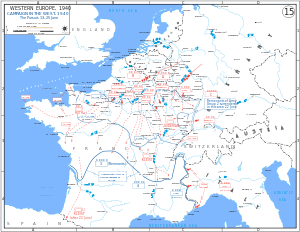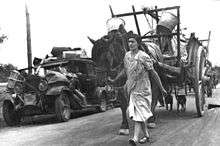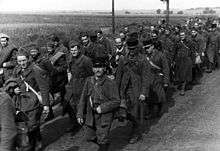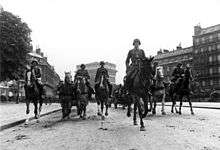Fall Rot
| Fall Rot | |
|---|---|
| Part of The Battle of France | |
 Fall Rot (Case Red) | |
| Location | France |
| Objective | |
| Executed by | German army |
| Outcome | German victory |
During World War II, Fall Rot (Case Red) was the plan for the second phase of the conquest of France by the German Army and began on 5 June 1940. It had been made possible by the success of Fall Gelb (Case Yellow), the invasion of the Benelux countries and northern France in the Battle of France and the encirclement of the Allied armies in the north on the Channel coast. Powerful forces were also to advance into France.[1]
Fall Rot consisted of two sub-operations, a preliminary attack in the west began on 5 June, over the river Somme in the direction of the Seine and the main offensive by Army Group A started on 9 June in the centre over the river Aisne.[1]
Background
French defensive preparations

By the end of May 1940, the best and most modern French armies had been sent north and lost in the resulting encirclement; the French had also lost much of their heavy weaponry and their best armoured formations. Overall, the Allies had lost 61 divisions in Fall Gelb. Weygand was faced with the prospect of defending a long front (stretching from Sedan to the Channel), with a greatly depleted French Army now lacking significant Allied support. Weygand had only 64 French and the 51st (Highland) Infantry Division available. Weygand lacked the reserves to counter a breakthrough or to replace frontline troops, should they become exhausted from a prolonged battle on a front of 965 km (600 mi). The Germans had 142 divisions to use and total control of the air except over the English Channel.[2]
The French also had to deal with millions of civilian refugees fleeing the war in what became known as L'Éxode (The Exodus); automobiles and horse-drawn carts carrying possessions clogged roads. As the government had not foreseen such a rapid military collapse, little planning existed. Between six and ten million French fled, sometimes so quickly that they left uneaten meals on tables, even while officials stated that there was no need to panic and that civilians should stay. The population of Chartres declined from 23,000 to 800 and Lille from 200,000 to 20,000, while cities in the south such as Pau and Bordeaux rapidly grew in size.[3]
Italy
Italy declared war on France and Britain on the evening of 10 June, to take effect just after midnight. The two sides exchanged air raids on the first day of war but little transpired on the Alpine front, since both France and Italy had adopted a defensive strategy. There was some skirmishing between patrols and the French forts of the Ligne Alpine exchanged fire with their Italian counterparts of the Vallo Alpino. On 17 June, France announced that it would seek an armistice with Germany. On 21 June, with a Franco-German armistice about to be signed, the Italians launched a general offensive all along the Alpine front, with the main attack in the northern sector and a secondary advance along the coast.[4] The offensive was conducted by 32 Italian divisions and penetrated a few kilometres into French territory against the Army of the Alps (General René Olry) with three divisions. The coastal town of Menton was captured and on the Côte d'Azur the invasion was held up by a French NCO and seven men.[5] On the evening of 24 June, an armistice was signed at Rome and came into effect just after midnight on 25 June, at the same time as the Second Armistice at Compiègne with Germany, which had been signed on 22 June.[4]
Prelude
The Battle of Abbeville took place from the 28 May to 4 June 1940 near Abbeville during the Battle of France in the Second World War. While Operation Dynamo, the Dunkirk evacuation, was under way, General Maxime Weygand attempted to exploit the immobilisation of German forces to attack northwards over the Somme and rescue the trapped Allied forces in the Dunkirk pocket. The Allied attack was carried out by the French 2e Division cuirassée (2nd DCR) and 4e Division cuirassée (4th DCR) and the British 1st Armoured Division. It comprised 500 tanks and 4 Infantry divisions. In spite of Allied success which shattered German defences on the ground, the attack failed due to the general breakdown of the French and British armies.[6]
Battle
Weygand line
The Germans renewed their offensive on 5 June on the Somme. During the next three weeks, far from the easy advance the Wehrmacht expected, they encountered strong resistance from a rejuvenated French Army.[7] It had fallen back on its lines of supply and communications and had closer access to repair shops, supply dumps and stores. About 112,000 evacuated French soldiers were repatriated via the Normandy and Brittany ports. It was some substitute for the lost divisions in Flanders. The French were also able to make good a significant amount of their armoured losses and raised the 1st and 2nd DCR (heavy armoured divisions). De Gaulle's division—the 4th DCR—also had its losses replaced. Morale rose and was very high by the end of May 1940.[8]
Morale was high because most French soldiers that knew about the defeats and were now joining the line, only knew of German success by hearsay; surviving French officers had increased tactical experience against German mobile units; increased confidence in their weapons after seeing their artillery, which the Wehrmacht post-battle analysis recognised as technically very good and their tanks perform better in combat than the German armour. The French tanks were now known to have heavier armour and armament.[9] Between 23 and 28 May, they reconstituted the French Seventh and Tenth armies. Weygand decided on hedgehog tactics, which were to implement defence in depth operations and use delaying tactics, to inflict maximum attrition on German units. He employed units in towns and small villages, prepared for all-round defence. Behind this, the new infantry, armoured and half-mechanised divisions formed up, ready to counter-attack and relieve the surrounded units, which were ordered to hold out at all costs.[10]

Army Group B attacked either side of Paris. Of its 47 divisions it had the majority of the mobile units.[2] After 48 hours, the Germans had not made any major breakthroughs; the Germans had been "stopped in their tracks".[11] On the Aisne, Erich Hoepner's XVI Panzerkorps employed over 1,000 AFVs, two panzer divisions and a motorised division against the French. The assault was crude and Hoepner soon lost 80 out of 500 AFVs in the first attack. The German 4th Army captured bridgeheads over the Somme but the Germans struggled to get over the Aisne.[12] Weygand had organised a defence in depth and frustrated the crossing.[13] At Amiens, the Germans were repeatedly driven back by powerful French artillery concentrations and came to recognise improved French tactics.
Once again, the German Army relied on the Luftwaffe to provide decisive assistance in silencing French guns and enabling the German infantry to inch forward.[14] German progress was made only late on the third day of operations, finally forcing crossings. The French Air Force attempted to bomb them, but failed. German sources acknowledged the battle was "hard and costly in lives, the enemy putting up severe resistance, particularly in the woods and tree lines continuing the fight when our troops had pushed passed the point of resistance".[15] South of Abbeville, the French Tenth Army (General Robert Altmayer) had its front broken and it was forced to retreat to Rouen and south along the Seine river. The rapid German advances were the sign of a weakening enemy. The 7th Panzer Division headed west over the Seine river through Normandy and captured the port of Cherbourg on 18 June. On the way to Cherbourg, Rommel forced the surrender of the British 51st (Highland) Division on 12 June.[16] In close-quarter combat, the Luftwaffe was struggling to have an impact. However, in an operational sense, they helped disperse French armour. The German spearheads were overextended and vulnerable to counter strokes, but the concentration of the Luftwaffe denied the French the ability to concentrate and the fear of air attack negated their mass and mobile use by Weygand.[17]

On 10 June, the French government declared Paris an open city.[18] The German 18th Army now deployed against Paris. The French resisted the approaches to the capital strongly, but the line was broken in several places. Weygand now asserted it would not take long for the French Army to disintegrate.[19] On 13 June, Churchill attended a meeting of the Anglo-French Supreme War Council at Tours. He suggested a Franco-British Union, which the French rejected.[20] On 14 June, Paris fell.[16] Those Parisians who stayed in the city found that in most cases the Germans were extremely well mannered.[21]
On top of this added danger, the situation in the air had also grown critical. The Luftwaffe established air supremacy (as opposed to air superiority) as the French air arm was on the verge of collapse.[22] The French Air Force (Armée de l'Air) had only just begun to make the majority of bomber sorties; between 5 and 9 June (during Operation Paula), over 1,815 missions, of which 518 were by bombers, were flown. The number of sorties flown declined as losses were now becoming impossible to replace. The RAF attempted to divert the attention of the Luftwaffe with 660 sorties flown against targets over the Dunkirk area, but losses were heavy; on 21 June alone, 37 Bristol Blenheims were destroyed. After 9 June, French aerial resistance virtually ceased; some surviving aircraft withdrew to French North Africa. Luftwaffe attacks concentrated on the direct and indirect support of the German Army. The Luftwaffe subjected lines of resistance to ferocious assault, which then quickly collapsed under armoured attack.[23]
Maginot line

Meanwhile, to the east, Army Group C was to help Army Group A encircle and capture the French forces on the Maginot line. The goal of the operation was to envelop the Metz region, with its fortifications, to prevent a French counter-offensive from the Alsace region against the German line on the Somme. Guderian's XIX Korps was to advance to the French border with Switzerland and trap the French forces in the Vosges Mountains while the XVI Korps attacked the Maginot Line from the west, into its vulnerable rear to take the cities of Verdun, Toul and Metz. The French, meanwhile, had moved the French 2nd Army Group from the Alsace and Lorraine to the 'Weygand line' on the Somme, leaving only small forces guarding the Maginot line. After Army Group B had begun its offensive against Paris and into Normandy, Army Group A began its advance into the rear of the Maginot line. On 15 June, Army Group C launched Operation Tiger, a frontal assault across the Rhine into France.[24]
German attempts to break the Maginot line prior to Tiger had failed. One assault lasted for eight hours on the extreme north of the line, costing the Germans 46 dead and 251 wounded, while just two French were killed at Ouvrage Ferme Chappy (Ouvrage: shelter) and one at Ouvrage Fermont). On 15 June, the last well-equipped French forces, including the Fourth Army, were preparing to leave as the Germans struck. The French now holding the line were skeletal. The Germans greatly outnumbered the French. They could call upon the I Armeekorps of seven divisions and 1,000 artillery pieces, although most were First World War vintage and could not penetrate the thick armour of the fortresses. Only 88 mm guns were effective and 16 were allocated to the operation. To bolster this, 150 mm and eight railway batteries were also employed. The Luftwaffe deployed the Fliegerkorps V.[25]
The battle was difficult and slow progress was made against strong French resistance. However, each fortress was overcome one by one.[26] Ouvrage Schoenenbourg fired 15,802 75 mm rounds at attacking German infantry. It was the most heavily shelled of all the French positions. Nevertheless, its armour protected it from fatal damage. The same day Tiger was launched, Operation Kleiner Bär began. Five assault divisions of the VII Armeekorps crossed the Rhine into the Colmar area with a view to advancing to the Vosges Mountains. It had 400 artillery pieces bolstered by heavy artillery and mortars. They drove the French 104th Division and 105th Division back into the Vosges Mountains on 17 June. On the same day Guderian's XIX Korps reached the Swiss border and the Maginot defences were cut off from the rest of France. Most units surrendered on 25 June and the Germans claimed to have taken 500,000 prisoners. Some main fortresses continued the fight, despite appeals for surrender. The last only capitulated on 10 July, after a request from General Alphonse Joseph Georges and only then under protest. Of the 58 big fortifications on the Maginot Line, ten were captured by the German army.[27]
Aftermath
Second BEF evacuation
The evacuation of the second BEF took place during Operation Ariel between 15 and 25 June. The Luftwaffe, with complete domination of the French skies, was determined to prevent more Allied evacuations after the Dunkirk debacle. Fliegerkorps I was assigned to the Normandy and Brittany sectors. On 9 and 10 June, the port of Cherbourg was subject to 15 tonnes of German bombs, while Le Havre received 10 bombing attacks that sank 2,949 GRT of escaping Allied shipping. On 17 June, Junkers Ju 88s—mainly from Kampfgeschwader 30—sank a "10,000 tonne ship" which was the 16,243 GRT liner RMS Lancastria off St Nazaire, killing some 4,000 Allied personnel (nearly doubling the British killed in the battle of France). Nevertheless, the Luftwaffe failed to prevent the evacuation of some 190,000–200,000 Allied personnel.[28]
Armistice

Discouraged by his cabinet's hostile reaction to a British proposal to unite France and Britain to avoid defeat and believing that his ministers no longer supported him, Prime Minister Paul Reynaud resigned on 16 June. He was succeeded by Marshal Philippe Pétain, who delivered a radio address to the French people announcing his intention to ask for an armistice with Germany. When Hitler received word from the French government that they wished to negotiate an armistice, he selected the Forest of Compiègne as the site for the negotiations.[29] Compiègne had been the site of the 1918 Armistice, which ended the First World War; Hitler viewed the choice of location as a supreme moment of revenge for Germany over France.[30] On 21 June 1940, Hitler visited the site in order to start the negotiations which took place in the railway carriage in which the 1918 Armistice was signed (it had just been removed from a museum building and placed on the spot where it was located in 1918). Hitler sat in the same chair in which Marshal Ferdinand Foch had sat when he faced the defeated German representatives.[31] After listening to the preamble, Hitler left the carriage in a calculated gesture of disdain for the French delegates and negotiations were turned over to Wilhelm Keitel, the Chief of Staff of the OKW. The armistice was signed on the next day at 6:36 p.m. (French time), by General Keitel for Germany and General Charles Huntziger for France. The armistice and cease-fire went into effect, two days and six hours later, at 12:35 a.m. on 25 June, once the Franco-Italian Armistice had been signed, at 6:35 p.m. on 24 June, near Rome.[4]
See also
Footnotes
- 1 2 Frieser 2005, p. 315.
- 1 2 Healy 2008, p. 84.
- ↑ Jackson 2001, pp. 119–120.
- 1 2 3 Frieser 2005, p. 317.
- ↑ Horne 1982, p. 631.
- ↑ Ellis 2004, pp. 259–271.
- ↑ Alexander 2007, p. 219.
- ↑ Alexander 2007, pp. 225–226.
- ↑ Alexander 2007, p. 227.
- ↑ Alexander 2007, pp. 231, 238.
- ↑ Alexander 2007, p. 248.
- ↑ Alexander 2007, p. 245.
- ↑ Maier et al. 1991, p. 297.
- ↑ Alexander 2007, p. 249.
- ↑ Alexander 2007, p. 250.
- 1 2 Healy 2008, p. 85.
- ↑ Alexander 2007, p. 240.
- ↑ Shirer 1990, p. 738.
- ↑ Maier et al. 1991, p. 300.
- ↑ Maier et al. 1991, p. 301.
- ↑ Shirer 1941.
- ↑ Hooton 2008, p. 86.
- ↑ Hooton 2008, pp. 84–85.
- ↑ Romanych & Rupp 2010, p. 52.
- ↑ Romanych & Rupp 2010, p. 56.
- ↑ Romanych & Rupp 2010, pp. 56–80.
- ↑ Romanych & Rupp 2010, pp. 90–91.
- ↑ Hooton 2008, p. 88.
- ↑ Evans 2000, p. 156.
- ↑ Taylor 1974, p. 57.
- ↑ Dear & Foot 2001, p. 326.
References
- Alexander, M. S. (April 2007). "After Dunkirk: The French Army's Performance Against Case Red, 25 May to 25 June 1940". War in History. 14 (2): 219–264. doi:10.1177/0968344507075873. ISSN 0968-3445.
- Dear, I.; Foot, M. (2001). The Oxford Companion to World War II. London: Oxford University Press. ISBN 0-19-860446-7.
- Ellis, Major L. F. (2004) [1st. pub. HMSO 1954]. Butler, J. R. M., ed. The War in France and Flanders 1939–1940. History of the Second World War United Kingdom Military Series. Naval & Military Press. ISBN 978-1-84574-056-6. Retrieved 6 September 2015.
- Evans, Martin Marix (2000). The Fall of France: Act of Daring. Oxford: Osprey. ISBN 1-85532-969-7.
- Frieser, K-H. (2005). The Blitzkrieg Legend (English trans. ed.). Annapolis, MD: Naval Institute Press. ISBN 1-59114-294-6.
- Guderian, H. (1976) [1952]. Panzer Leader (Futura repr. ed.). London: Michael Joseph. ISBN 0-8600-7088-3.
- Healy, M.; Prigent, J., eds. (2008). Panzerwaffe: The Campaigns in the West 1940. I. London: Ian Allen. ISBN 978-0-7110-3240-8.
- Hooton, E. R. (2008) [1994]. Phoenix Triumphant: The Rise and Rise of the Luftwaffe. London: Brockhampton Press. ISBN 1-86019-964-X.
- Horne, A. (1982) [1969]. To Lose a Battle: France 1940 (Penguin repr. ed.). London: Macmillan. ISBN 0-14-00-5042-6.
- Jackson, Julian (2001). France: The Dark Years, 1940–1944. Oxford University Press. ISBN 0-19-820706-9.
- Maier, K.; Rohde, H.; Stegemann, B.; Umbreit, H. (1991). Die Errichtung der Hegemonie auf dem europäischen Kontinent [Germany's Initial Conquests in Europe]. Germany and the Second World War. II (English trans. ed.). London: Oxford University Press. ISBN 0-19-822885-6.
- Romanych, M.; Rupp, M. (2010). Maginot Line 1940: Battles on the French Frontier. Oxford: Osprey. ISBN 978-1-84603-499-2.
- Shirer, William L. (1941). Berlin Diary: The Journal of a Foreign Correspondent, 1934–1941. Simon & Schuster. OCLC 366845.
- Shirer, William L. (1990). The Rise and Fall of the Third Reich: A History of Nazi Germany. New York: Knopf. ISBN 0-671-72868-7.
- Taylor, A. J. P. (1974). Mayer, S. L., ed. A History of World War Two. London: Octopus Books. ISBN 0-7064-0399-1.
Further reading
- Benoist-Méchin, J. (1956). Soixante jours qui ébranlèrent l'occident: 10 mai – 10 juillet 1940 [Sixty Days that Shook the West: The Fall of France 1940] (in French). Paris: A. Michel. OCLC 836238123.
- Prételat, A–G. (1950). Le Destin Tragique de la Ligne Maginot [The Tragic Destiny of the Maginot Line]. La Seconde Guerre mondiale, histoire et souvenirs (in French). Paris: Berger-Levrault. OCLC 12905841.
- Rodolfe, R. (1949). Combats dans la Ligne Maginot [Operations on the Maginot Line] (in French). Paris: Ponsot. OCLC 12905932.
- Wright, D. P., ed. (2013). 16 Cases of Mission Command (PDF). Fort Leavenworth, KS: Combined Studies Institute Press US Army Combined Arms Center. ISBN 0-98913-721-X. Retrieved 5 September 2015.